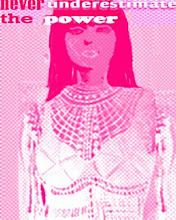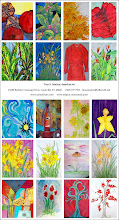Below is the quote that IF sent out with this week's topic "Pattern." My ink illustration "Sangria" is one of my favorites that show a pattern.
Sunday, September 27, 2009
"Pattern" is the 9/25 Illustration Friday topic
Below is the quote that IF sent out with this week's topic "Pattern." My ink illustration "Sangria" is one of my favorites that show a pattern.
Tuesday, September 22, 2009
Infinite
Labels:
constant,
domestic life,
duties,
household chores,
illustration friday,
infinite,
mother,
never ending,
responsibility,
wife,
women
Friday, September 11, 2009
Illustration Friday topic: "Welcome"
 This week's Illustration Friday topic "Welcome" arrived with the quote: "The soul should always stand ajar, ready to welcom the ecstatic experience. - Emily Dickinson."
This week's Illustration Friday topic "Welcome" arrived with the quote: "The soul should always stand ajar, ready to welcom the ecstatic experience. - Emily Dickinson."I immediatly thought of this illustration for my entry. When I pulled up the jpeg on my computer, I was pleasantly surprised to see the word "welcome" written at the door.
Tuesday, September 8, 2009
Illustration Friday topic: "Strong"

This week's Illustration Friday topic is Strong: "Nonviolence is a weapon of the strong. ~ Mahatma Gandhi" (suggested by Andre).
It was difficult for me to select an illustration. My first thought choice was an ink of the Christian wooden cross. Jesus of Nazareth was an itenerant preacher and the Christian Messiah who was brutally tortured and crucified, despite his message of peace. You can find this illustration "I am the Vine" on http://www.smackinart.etsy%20com/ in my "Prints and Note Cards" category.
My second thought was my ACEO commemorating a rowing team from the 1975 Pan American Games in Mexico City. Interestly, Santiago, Chile, had originally been awarded the games; but, political upheaval forced a change of venue. You can find this ACEO "Ochre Bleu Grenada Row" on http://www.smackinart.etsy%20com/ in my "ACEO" category.
The third, above, was my whimsical interpretation of John Lennon. Mr. Lennon wrote many songs of love and peace. My favorite song is aptly titled "Give Peace a Chance" written in 1969. Sadly, Mr. Lennon was gunned down in 1980.
What is it about the nonviolent that causes such a violent reaction?
Labels:
gandhi,
hippie,
illustration friday,
john lennon,
nonviolence,
nonviolent,
peace,
smackinart,
strong,
teambluegrass,
watercolor
Tuesday, September 1, 2009
Why "should" I want to buy that?
Last week, a man walked into my art studio, looked around and stopped at a table display of my ACEOs.
"Now, what are these?" he asked.
I explained the cards were ACEOs, small art pieces similiar to the wallet-sized cards European artists from centuries ago gave away to advertise their work. And, although ACEO stands for Art Card Editions and Originals , at this time, my cards are original and one of a kind.
, at this time, my cards are original and one of a kind.
"Cool," he said casually flipping through the stack. "Now, tell me why should I want to buy one."
Easy. ACEOs are an inexpensive way to collect an artist's work.
After he looked through the stack on the table, I directed him to other ACEOs around the room. He chatted about the different styles of cards I offer: ACEOs with original illustrations, collages and watercolors... some embellished with fiber and some with stamps I collected in the late 1970s - early 1980s. (However, my latest ACEO sports a recent postage stamp of Seabiscuit.)
"Nice," he mused hand on his chin. "What would I do with them? Like, where would I put them?"
The possibilities are many. Some collectors keep ACEOs in a photo or card collecting album. Some mat and frame a grouping of the cards. An ACEO can be proped on miniature easel or tacked on bulletin board. They make nice a bookmark, keepsake, card enclosure, meditation piece or graphic element in a scrapbook.
"Great! Thank you! I love your work," he enthused, then shook my hand and left.
Well... I admit I had hoped for a sale, large or small. No such luck. Another day...
Check out my ACEO cards at http://www.smackinart.com/ and http://www.smackinart.etsy.com/.
More about ACEOs:
(1) ACEOs are the size of a sport trading card (2 ½ X 3 ½ inches).
(2) ACEOs are sold, while Art Trading Cards (ATCs) are traded.
(3) The ACEO Movement was founded by artist Lisa Luree.
(4) (information courtesy of Art-Cards.org) Sixteenth century art cards were typically nude paintings of mistresses commissioned by men from the same artists who painted large portraits of their children or wives. Eighteenth century artists used art cards as an advertising tool. Impressionist artists traded art cards among themselves to study and sold or traded to others for supplies, food and lodging.
"Now, what are these?" he asked.
I explained the cards were ACEOs, small art pieces similiar to the wallet-sized cards European artists from centuries ago gave away to advertise their work. And, although ACEO stands for Art Card Editions and Originals
"Cool," he said casually flipping through the stack. "Now, tell me why should I want to buy one."
Easy. ACEOs are an inexpensive way to collect an artist's work.
After he looked through the stack on the table, I directed him to other ACEOs around the room. He chatted about the different styles of cards I offer: ACEOs with original illustrations, collages and watercolors... some embellished with fiber and some with stamps I collected in the late 1970s - early 1980s. (However, my latest ACEO sports a recent postage stamp of Seabiscuit.)
"Nice," he mused hand on his chin. "What would I do with them? Like, where would I put them?"
The possibilities are many. Some collectors keep ACEOs in a photo or card collecting album. Some mat and frame a grouping of the cards. An ACEO can be proped on miniature easel or tacked on bulletin board. They make nice a bookmark, keepsake, card enclosure, meditation piece or graphic element in a scrapbook.
"Great! Thank you! I love your work," he enthused, then shook my hand and left.
Well... I admit I had hoped for a sale, large or small. No such luck. Another day...
Check out my ACEO cards at http://www.smackinart.com/ and http://www.smackinart.etsy.com/.
More about ACEOs:
(1) ACEOs are the size of a sport trading card (2 ½ X 3 ½ inches).
(2) ACEOs are sold, while Art Trading Cards (ATCs) are traded.
(3) The ACEO Movement was founded by artist Lisa Luree.
(4) (information courtesy of Art-Cards.org) Sixteenth century art cards were typically nude paintings of mistresses commissioned by men from the same artists who painted large portraits of their children or wives. Eighteenth century artists used art cards as an advertising tool. Impressionist artists traded art cards among themselves to study and sold or traded to others for supplies, food and lodging.
Labels:
aceo,
acetsy,
art,
art card,
art trading card,
atc,
collage,
collectibles,
original art,
small,
teambluegrass,
vintage stamps,
watercolor,
why buy an aceo
Subscribe to:
Posts (Atom)





